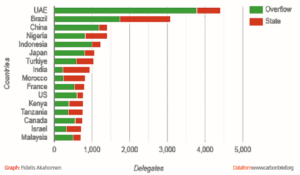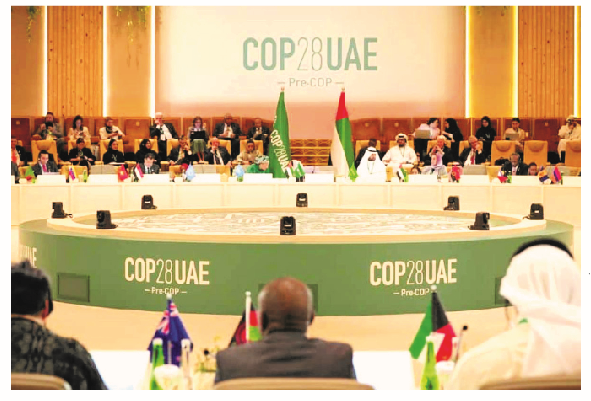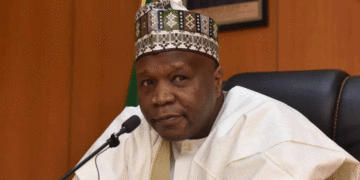No fewer than 1,411 Nigerian delegates, enough to fill two or three jumbo jets, registered to participate at the 28th Climate Change Summit presently holding in Dubai, the United Arab Emirates. That is, the meeting of the Conference of the Parties to the United Nations Framework Convention on Climate Change (UNFCCC).
And according to data published by UNFCCC, about 97,000 delegates registered to attend in person, with another 3,000 registering to participate virtually, making it the largest COP conference in history and almost twice the number that travelled to Sharm El-Sheikh in Egypt for COP27 last year, the previous largest in an almost 30-year history of summits.
16,000 of the participants in the COP28 conference are however support staff.
The delegates are categorised into three groups; those representing countries, who make up the bulk of participants, those representing Non-Governmental Organizations and those representing the media.
Carbon Brief, a UK-based website that reports the latest developments in climate science, climate policy and energy policy published an analysis of the list of participants that showed Nigeria with the third highest number of registered delegates. Along with Nigeria, China also registered 1411 delegates.
Only the host country, the United Arab Emirates with 4,409 delegates and Brazil with 3,081 delegates had more registered participants. Carbon Brief however reported that the final list of participants will not be published by UNFCCC until after the conference as not all registered participants actually make it to the conference.
An example of that is Nigeria’s minister of information, Mohammed Idris Malagi who registered for the conference but ended up not attending.

Nigeria’s large delegation is coming at a time of economic difficulties, which have left Nigerians groaning under the weight of inflation, higher fuel prices, rising food and drug prices and stagnant wages.
Yet, the cost of governance, right from running the presidency to paying a large bureaucratic workforce, has continued to eat away at Nigeria’s finances.
It is however not clear how many of the 1,411 participants who make up Nigeria’s delegation are part of the government’s representation, how many represent NGOs and how many are media representatives.
LEADERSHIP Sunday could also not determine whether the entire 1,411 delegates were sponsored by the Nigerian government or were part of a private sector team.
Apart from the cost of flying and parking the presidential jet in the United Arab Emirates for the duration of the conference, hundreds of millions of Naira would be needed for flight tickets for the majority who could not squeeze themselves into the presidential jet.
Millions of Naira more would also be needed for accommodation and feeding in Dubai, known to be one of the most expensive cities in the world to visit and live in.
COP28: Tinubu Unveils 100 Electric Buses To Cut Nigeria’s Carbon Footprint
At present, there is no direct flight from Nigeria to Dubai as Emirate Airline stopped operation into Nigeria due to some irreconcilable difference between Nigeria and the United Arab Emirates (UAE).
However, an average ticket on Turkish and Ethiopian airlines is about $2,400 for a return ticket from Abuja to Dubai.
With a prevailing rate of N1,160 at the parallel market, a return ticket would be about N2.78million.
However, with a delegation of 1,411 to the COP28 World for the world climate action summit, the country would have spent a large sum on air tickets.
Nigeria’s large delegation only came to light due to the publication of the list of registered participants by UNFCCC.
Since coming into office in May 2023, President Bola Tinubu has also made several international trips to attend summits without the presidency releasing to full list of those that make up his official delegation.
President Tinubu made his first official trip to France on June 20, to attend the Summit for a New Global Financing Pact.
On July 8, the president was in Guinea Bissau and again on November 16 to celebrate the country’s 50th anniversary. He visited Kenya on July 15 for the AU Summit and on August 1, the president was in Benin Republic.
He went to India on September 5 fort the G20 Summit in New Delhi. And a few days later, he arrived New York, the United States of America for the UN General Assembly meeting.
The president was in Saudi Arabia on November 8, Germany on November 19 and is presently on a visit to the UAE.
Record numbers in UAE
For the first time in COP history, the participant lists have been published by the United Nations Framework Convention on Climate Change (UNFCCC) in spreadsheet format, rather than as pdf documents. (A summary pdf file of the overall participant totals has also now been published.)
The provisional total for COP28 suggests that 97,372 delegates have registered to attend the summit in person. With a further 3,074 attending virtually, this takes the overall total to 100,446.
As the chart below shows, this comfortably makes the Dubai event the largest COP in history. For comparison, the first climate COP – held in Berlin in 1995 – had 3,969 delegates.
Last year’s COP in Sharm El-Sheikh received almost 50,000 delegates, which put it some distance ahead of the 38,000 that attended COP26 in Glasgow in 2021. It highlights a trend of increasing participation at climate COPs following a dip in attendance after the peak of COP21 in Paris in 2015.
It should be noted that these are provisional figures, based on the delegates that have registered for the summit. The UNFCCC will release the final figures – based on participants collecting a physical badge at the venue – after the summit has closed.
As usual, the lists are divided between the different types of groups and organisations attending the summit. The largest group at COP28 is for delegates representing parties. These are nation states, plus the European Union, that have ratified the convention and play a full part in negotiations. This group adds up to 24,488 delegates – more than double the number at COP27 last year.
The next-largest group is that of observers from non-governmental organisations (NGOs), which totals 14,338 delegates – again, comfortably the largest for this group in COP history.
Along with the NGOs, there are several other groups that fall into the category of “observer organisations” – such as those participants representing UN bodies, intergovernmental organisations, other agencies and business representatives. These total 3,623 registered delegates – or 4,754 when overflow badges are included.
Finally, another record-breaking group is the number of media delegates – clocking in at 3,972. This total potentially tops the 3,712 media representatives at COP3 in Kyoto in 1997.





